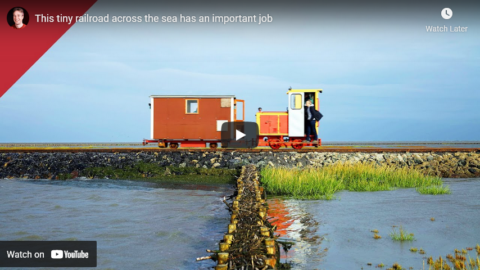Tom Scott
Published 5 Sep 2022The @Royal Albert Hall is 150 years old; the roof is 600 tonnes of glass and steel. And it turns out that there’s a terrifying technicians’ trampoline, acoustic-dampening mushrooms, and a complete lack of connections.
(more…)
January 6, 2023
This is the most interesting roof in London
January 5, 2023
Tank Chats #162 | Springer | The Tank Museum
The Tank Museum
Published 2 Sep 2022Join Curator David Willey in his latest Tank Chat as he delves into the Springer, a German demolition vehicle.
(more…)
November 6, 2022
How Do You Steer a Drill Below The Earth?
Practical Engineering
Published 5 Jul 2022When the commotion of construction must be minimized, try horizontal directional drilling!
Like laparoscopic surgery for the earth, horizontal directional drilling (or HDD) doesn’t require digging open a large area like a shaft or a bore pit to get started. Instead, the drill can plunge directly into the earth’s surface. From there, horizontal directional drilling is pretty straightforward, but it’s not necessarily straight. In fact, HDD necessarily uses a curved alignment to enter the earth, travel below a roadway or river, and exit at the surface on the other side.
(more…)
October 26, 2022
Four Myths About Construction Debunked
Practical Engineering
Published 21 Jun 2022
Let’s set the record straight for a few construction misconceptions!Errata: The shot at 4:16 is of the Greek Acropolis (not a Roman structure).
Over the past 6 years of reading emails and comments from people who watch Practical Engineering, I know that parts of heavy construction are consistently misunderstood. So, I pulled together a short list of the most common misconceptions. Hope you don’t mind just a little bit of ranting from me 😉
(more…)
September 28, 2022
This Is Why We Can’t Have Nice Infrastructure
Kite & Key Media
Published 31 May 2021America is a land of constant progress. Sometimes it seems like there’s nothing we can’t accomplish. And then we try to build something…
In recent years, infrastructure projects have taken way too long and cost way more than they should. Boston’s “Big Dig”, for example, took 15 years and cost more than 5x as much as projected. California’s High-Speed Rail was supposed to run between L.A. and San Francisco by 2020. Instead, some track nowhere near either city might be ready by 2027.
Why can’t America build quickly or cost effectively anymore? A well-intentioned regulatory law from the 1970s has a lot to do with it…
When the National Environmental Policy Act (NEPA) first took effect in the 1970s, the environmental impact analysis it required from builders before a project could begin would often run less than 10 pages. Today, the average is more than 600 pages.
Maybe delays and ballooning costs are worth it to protect the planet, right? Here’s the crazy part: NEPA doesn’t even guarantee that. In some cases, it’s actually making us less green.
(more…)
August 18, 2022
The bridge design that helped win World War II
Vox
Published 12 Mar 2021It’s a simple innovation that helped win a war.
The Bailey bridge was Donald Bailey’s innovative solution to a number of wartime obstacles. The allies needed a way to cross bodies of water quickly, but bombed-out bridges — or an absence of crossings entirely — made that incredibly difficult. That was only compounded by new, heavy tanks that needed incredibly strong support.
Bailey’s innovation — a modular, moveable panel bridge — solved those problems and gave the allies a huge advantage. The 570-pound steel panel could be lifted by just six men, and the supplies could fit inside small service trucks. Using those manageable materials, soldiers could build crossings sufficient for heavy tanks and other vehicles.
As impressive, the Bailey bridge could be rolled across a gap from one side to the other, making it possible to build covertly or with little access to the other side. Together, all the Bailey bridge’s advantages changed bridge construction and may have helped win the war.
(more…)
August 9, 2022
July 9, 2022
QotD: Chinese “technocracy”
For a while, all (or almost all) of China’s top officials had engineering degrees.
When Xi Jinping first joined the Politburo Standing Committee in 2008, eight of its nine members were engineers. Paramount Leader Hu Jintao was a hydroelectric engineer. His second-in-command Wen Jiabao was a geological engineer. There were two electrical engineers, a petroleum engineer, a radio engineer, and two chemical engineers (including Xi himself). The only non-engineer was Li Keqiang, an economist.
And this was actually a low point in engineers’ dominance of Chinese power. The term before, 100% of Politburo Standing Committee officials had been engineers! What’s going on?
For one thing, Deng Xiaoping thought engineers were cool, and he was powerful enough to do whatever he wanted. A government made up entirely of engineers? Sure, whatever you say. And since the top echelons of Chinese government appoint their own successors, these engineers could appoint other engineers and so on.
But also: during the Cultural Revolution, about half of Chinese people who got degrees at all got engineering degrees. The Cultural Revolutionaries were really not big on education (according to one article, “Xi’s secondary education [was cut short] when all secondary classes were halted for students to criticise and fight their teachers.”) But engineering was useful for building factories, and so was grudgingly tolerated. That meant that of the people smart and ambitious enough to get into college at all, half did engineering.
The other half? I’m not sure. Law is a popular major for would-be politicians in the US, but here’s a Chinese person explaining why it doesn’t work that way in China (short version: China doesn’t have great rule of law, so lawyers don’t matter much and are low status).
Here is an article telling us not to take China’s engineer-kings too seriously. It argues that (aside from Deng’s original picks), most of them never did much engineering, and just studied the subject in school as a generic prestigious-sounding degree to springboard their government career. Chinese engineering curricula are easy, and powerful people frequently cheat or pay others to write their dissertations.Aside from a few of Deng’s personal picks, we should think of this less as “China is a magic place where rational scientists hold power”, and more as “for idiosyncratic reasons, social climbers in China got engineering degrees.” Certainly none of these people were selected for the Politburo on the basis of their engineering acumen. They got their power by bribing, flattering, and backstabbing people, just like everyone else.
In any case, Xi’s old Politburo class was the last one to be made primarily of engineers. The current Politburo has only one engineer — Xi himself.
Scott Alexander, “Dictator Book Club: Xi Jinping”, Astral Codex Ten, 2022-04-07.
April 6, 2022
How To Build a Nazi Fortress – WW2 Special
World War Two
Published 5 Apr 2022Few things of the Second World War are more intimidating than the iconic German bunker. Made out of reinforced concrete with a thickness of up to 3.5 meters, these casemates and pillboxes were incredibly tough to destroy. Built to withstand shells and bombs, they provided shelter to troops and civilians alike. But there were also some even larger super-structures. From giant U-Boat shelters and fearsome Flak-Towers, to the ultimate Führerbunker, the Germans perfected the art of bunker building.
(more…)
February 25, 2022
This tiny railway across the sea has an important job
Tom Scott
Published 15 Nov 2021The Lorenbahn, the Lüttmoorsiel-Nordstrandischmoor island railway, is famous for the tiny, private trains that take residents to and from the mainland. But that’s not why it was built: and it’s got a more useful purpose as well.
Thanks to everyone from Landesbetrieb für Küstenschutz, Nationalpark und Meeresschutz Schleswig-Holstein, and to the islanders, for all your time and patience!
Camera operator: Richard Bielau
Producer: Maximilian Thesseling of Klein Aber https://kleinaber.de/I’m at https://tomscott.com
on Twitter at https://twitter.com/tomscott
and on Instagram as tomscottgo
February 14, 2022
Why SpaceX Cares About Dirt
Practical Engineering
Published 2 Nov 2021Why do structures big and small sink into the ground, and what can we do to stop it?
Before the so-called Starbase supported crazy test launches of the Starship spaceflight program, it was just a pile of dirt. After nearly two years, they hauled most of that soil back off the site for disposal. It might seem like a curious way to start a construction project, but foundations are critically important. Building that giant dirt pile was a clever way to prevent these facilities from sinking into the ground over time.
Practical Engineering is a YouTube channel about infrastructure and the human-made world around us. It is hosted, written, and produced by Grady Hillhouse. We have new videos posted regularly, so please subscribe for updates. If you enjoyed the video, hit that ‘like’ button, give us a comment, or watch another of our videos!
CONNECT WITH ME
____________________________________
Website: http://practical.engineering
Twitter: https://twitter.com/HillhouseGrady
Instagram: https://www.instagram.com/practicalen…
Reddit: https://www.reddit.com/r/PracticalEng…
Patreon: http://patreon.com/PracticalEngineeringSPONSORSHIP INQUIRIES
____________________________________
Please email my agent at practicalengineering@standard.tvDISCLAIMER
____________________________________
This is not engineering advice. Everything here is for informational and entertainment purposes only. Contact an engineer licensed to practice in your area if you need professional advice or services. All non-licensed clips used for fair use commentary, criticism, and educational purposes.SPECIAL THANKS
____________________________________
This video is sponsored by Morning Brew.
Stock video and imagery provided by Getty Images, Shutterstock, and Videoblocks.
Tonic and Energy by Elexive is licensed under a Creative Commons Attribution License
Source: https://www.youtube.com/watch?v=U6fBP…
Producer/Writer/Host: Grady Hillhouse
Assistant Producer: Wesley Crump
January 30, 2022
Engineer’s Delight: Stemple 76/45 Becomes the Stemple Takedown Gun
Forgotten Weapons
Published 17 Sep 2021http://www.patreon.com/ForgottenWeapons
https://www.floatplane.com/channel/Fo…
Cool Forgotten Weapons merch! http://shop.forgottenweapons.com
The saga of how the original Stemple 76/45 became the Stemple Takedown Gun is a fantastic story of engineering design choices.
Essentially, John Stemple began by building a rather crude copy of the Swedish K in .45 ACP in the mid 1980s, called the Stemple 76/45. He produced and registered 2,000 transferrable receivers for the gun (pre-1986), but only built them slowly, a few at a time. In the late 1980s he faced criminal charges from ATF, and transferred the receivers to a friend while he (successfully) fought the charges. When he went to get the receivers back, his friend refused, and the two entered into a nearly decade-long legal battle over them.
By the time Stemple eventually won the case, he recovered about 900 transferrable tubes. By this time (circa 2000) these tube receivers were much more valuable than when he first made them, as the machine gun registry was closed in 1986 and new ones can no longer be made. At this point, Stemple reached out to Brian Poling (BRP Corp) to act as a subcontractor to make the parts for the Stemple 76/45. But Poling had a better idea …
Poling’s thought was to instead design a new gun that would be much more desirable as a recreational gun than the 76/45. He envisioned something controllable, low recoil, and using large drum magazines. Such a gun would be a lot more fun at the range than the MACs and Uzis that tended to dominate the submachine gun market at the time. In addition, Poling’s gun would be designed specifically to protect the irreplaceable registered receiver tubes from wear or damage. The result was the STG-76 — the Stemple Takedown Gun.
In order to remain legal, the STG-76 had to leave the original 76/45 receiver tube cutouts unmodified, so as not to change the configuration of the receiver itself. Poling designed a replaceable internal trunnion and slip-over magazine well, allowing multiple different calibers and magazine configurations. The internals were closely based on the Finnish kp31 Suomi, for which parts kits became readily available in the early 2000s. This also facilitated the use of Suomi 71-round drum magazines. The original STF-76 design also included a bipod for easy shooting, and a grip and stock from an HK91 or CETME Model C for comfortable handling (instead of the terrible metal strut stocks common to most budget SMGs).
Several other interesting configurations would follow (stay tuned for those videos), and the guns remain available brand new to this day. The original supply of receivers is sufficient for production until about 2023 …
Contact:
Forgotten Weapons
6281 N. Oracle 36270
Tucson, AZ 85740
January 8, 2022
Antique Antics: The Pantheon
Overly Sarcastic Productions
Published 7 Jan 2022It’s a good dome, simple as that.
SOURCES & Further Reading: The Great Courses lectures: “The Most Celebrated Edifice – The Pantheon” from Understanding Greek and Roman Technology by Stephen Ressler, and “Roman Art and Architecture” from The Roman Empire: From Augustus to The Fall of Rome by Gregory Aldrete. “The Pantheon” by Chris Legare via ATouchOfRome https://www.atouchofrome.com/the_pant…. Additionally, I have a university degree in Classical Studies.
Our content is intended for teenage audiences and up.
PATREON: https://www.Patreon.com/OSP
PODCAST: https://overlysarcasticpodcast.transi…
DISCORD: https://discord.gg/osp
MERCH LINKS: http://rdbl.co/osp
OUR WEBSITE: https://www.OverlySarcasticProductions.com
Find us on Twitter https://www.Twitter.com/OSPYouTube
Find us on Reddit https://www.Reddit.com/r/OSP/
November 8, 2021
Look at Life — Rendered Safe (1962)
September 22, 2021
The Extremely Bizarre Engineering Rituals of Canada (And the Fascinating Way They Came to Be)
Today I Found Out
Published 31 Jul 2021This video is #sponsored by NordVPN.
Sources:
Andrews, Gordon, Canadian Professional Engineering and Geoscience: Practice and Ethics, Thomson Nelson Canada Ltd, 2005
Kipling, Rudyard, “The Hymn of Breaking Strain”, 1935, http://www.cuug.ab.ca/~branderr/risk_…
2 Esdras 4:5-10, https://thekingjamesversionbible.com/…
Bateman, Chris, The Secrets of Engineering’s Strange and Mysterious Initiation Ritual, TVO, April 24, 2018, https://www.tvo.org/article/the-secre…
“Background: The Calling of an Engineer, The Ritual of the Calling of an Engineer”, https://www.ironring.ca/background-en/
Anderson, Bill, “Why Engineering is Purple”, April 16, 2019, https://profbillanderson.com/2019/04/…









